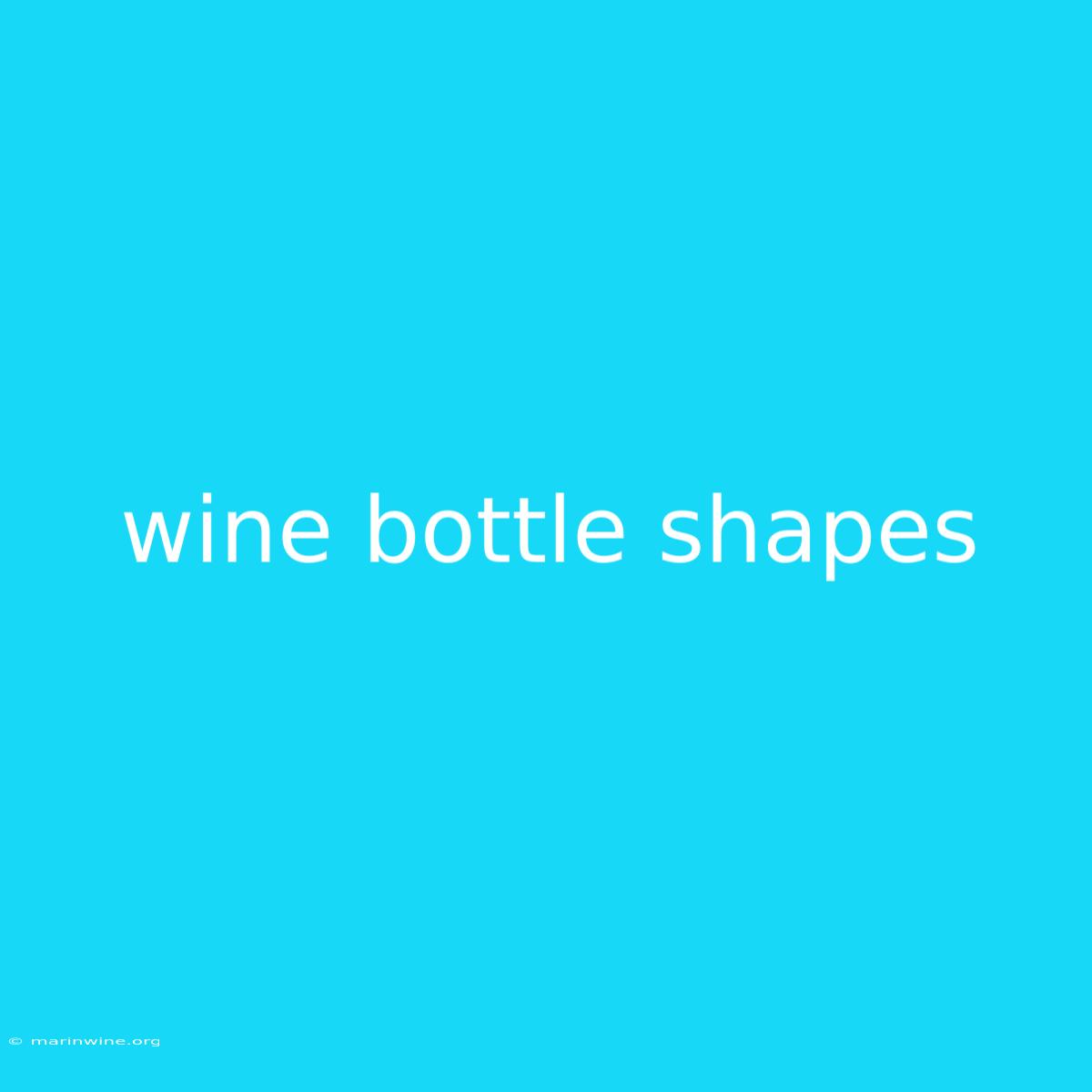Uncorking the Mystery: What Do Wine Bottle Shapes Really Mean?
Ever wondered why wine bottles come in so many different shapes? It's more than just aesthetics; each shape plays a role in the wine's journey from vineyard to glass. Let's explore the fascinating world of wine bottle shapes and what they reveal about the wine inside.
Why It Matters: Understanding wine bottle shapes helps you decipher clues about a wine's origin, style, and aging potential. It's an exciting way to engage with the world of wine, from appreciating the craftsmanship of the bottle to appreciating the nuanced flavors of the liquid inside.
Key Takeaways of Wine Bottle Shapes:
| Bottle Shape | Wine Style | Key Features |
|---|---|---|
| Bordeaux | Cabernet Sauvignon, Merlot, Bordeaux Blends | Tall, cylindrical, with a slightly rounded shoulder. Offers ample surface area for aging. |
| Burgundy | Pinot Noir, Chardonnay | Tall and slender, with a prominent shoulder. Designed for Burgundy's delicate wines. |
| Champagne | Sparkling Wine | Tall, with a distinctive flute-like shape. Offers elegant presentation and preserves bubbles. |
| Alsace | Riesling, Gewürztraminer, Pinot Gris | Tall and slender, with a distinctive "flute" shape. Similar to Burgundy but with a more pronounced shoulder. |
| Rhône | Syrah, Grenache, Côtes du Rhône Blends | Wide-shouldered, with a rounded body. Designed to showcase Rhône wines' full-bodied character. |
| Mosel | Riesling, Pinot Blanc, Müller-Thurgau | Slender and elongated, with a pronounced neck. Emphasizes Mosel Riesling's delicate aromas. |
| Chianti | Sangiovese | Fiasco (straw-covered bottle). Traditionally used to transport Chianti, now more for display. |
| Magnum | Various Wines | Double the size of a standard bottle, offering longer aging potential. |
Wine Bottle Shapes
Bordeaux: The quintessential Bordeaux bottle is a tall, cylindrical shape with a slightly rounded shoulder. This design provides a large surface area for the wine to interact with oxygen, facilitating aging and enhancing the complexity of the aromas.
Burgundy: The classic Burgundy bottle is tall and slender, with a prominent shoulder. Its shape promotes the development of delicate flavors and aromas, reflecting the lighter body of Burgundy wines like Pinot Noir and Chardonnay.
Champagne: The elegant, flute-like shape of a Champagne bottle serves a practical purpose: it preserves the effervescence of the wine, keeping the bubbles alive and vibrant. This shape also enhances the visual appeal of the champagne, making it a perfect choice for celebrations.
Alsace: The Alsace bottle resembles a Burgundy bottle but with a more pronounced shoulder. This design is particularly suited for the aromatic and complex wines of Alsace, showcasing their unique character.
Rhône: Rhône bottles boast a wide shoulder and rounded body, emphasizing the full-bodied nature of the wines produced in this region. These bottles often feature a distinctive punt (a recessed area at the bottom) to enhance the visual appeal and facilitate pouring.
Mosel: The Mosel bottle, known for its slender, elongated shape, highlights the delicacy and aromas of Riesling wines. Its narrow neck allows for a precise pour, preserving the wine's subtle nuances.
Chianti: The iconic Chianti bottle, known as a "fiasco," was traditionally used to transport the wine. This straw-covered bottle has become a symbol of Chianti and is now primarily used for display.
Magnum: A Magnum bottle holds twice the volume of a standard bottle, providing a larger surface area for the wine to breathe and age gracefully. This format offers an extended aging potential and allows the flavors to develop more complexity over time.
Beyond Shape:
While the bottle's shape is a vital clue, it's essential to consider other factors that influence a wine's character, such as:
- Grape Variety: The grape variety used to make the wine significantly impacts its flavor profile, acidity, and tannins.
- Vintage: The year the grapes were harvested can influence the wine's overall style and quality.
- Winemaking Techniques: Winemakers use various techniques during the winemaking process, like oak aging or fermentation methods, to shape the wine's flavor.
FAQ
Q: Are there specific bottle shapes associated with certain regions? A: Yes, many regions have developed traditional bottle shapes that reflect their unique winemaking styles.
Q: Do all bottles of the same shape contain the same wine? A: No, while bottle shape can be a good indicator, it's not a guaranteed sign. Many wines with similar styles might be bottled in similar shapes, but there are also variations within regions.
Q: Can the shape of the bottle affect the taste of the wine? A: While the shape itself doesn't directly impact the taste, it influences the wine's interaction with oxygen, which can affect its aging potential and complexity.
Tips for Wine Bottle Enthusiasts:
- Pay attention to the details: Notice the shape, the color of the glass, and any other distinctive features on the bottle.
- Do your research: Learn about the different wine regions and their traditional bottle shapes.
- Talk to a wine expert: Ask a sommelier or wine shop owner about their favorite bottles and what makes them unique.
- Explore the world of wine: Try different wines from various regions and explore the connection between the bottle shape and the wine's character.
Summary of Wine Bottle Shapes:
Wine bottle shapes are more than just decorative elements; they provide clues about the wine's origin, style, and aging potential. By understanding the different shapes, you can better appreciate the artistry and craftsmanship that go into creating the wines we enjoy.
Closing Message: The next time you're in a wine shop or at a restaurant, take a moment to observe the bottles and their shapes. This simple act can be a gateway to a deeper understanding and appreciation of the world of wine.

